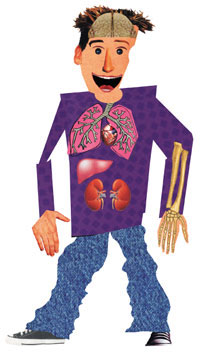NIDA scientists have teamed with Scholastic, a global children's publishing and media company, in a 2-year project designed to educate 12- to 15-year-olds about the dangers of drug abuse. Launched in October, Heads Up: Real News About Drugs and Your Body will reach more than 8.5 million students and teachers. The unique Heads Up series of Scholastic magazine articles will feature real-life accounts by young people in recovery from addiction along with lively original art to convey the latest scientific information about how drugs affect teens' brains, bodies, and lives.
 Stephen Kroninger; used with permission
Stephen Kroninger; used with permission"Science can be a challenging topic, and working with Scholastic in the Heads Up project, we're aiming to reach young people where they spend most of their daytime hours -- in the classroom," says NIDA Acting Director Dr. Glen R. Hanson. "We need to provide accurate, science-based information, and we hope this innovative format will help keep the students' attention on the important messages."
NIDA's Monitoring the Future survey for 2002 underlines the need for improving young teens' awareness of drug hazards, especially marijuana and nicotine, which continue to be the most frequently abused drugs, other than alcohol, in this age group:
- The number of 8th-graders who see regular marijuana use as a "great risk" for physical or other harm has fallen -- from about 75 percent in 2000 to 72 percent in 2002; 10th-graders with that perception decreased from about 65 percent to 61 percent.
- Nearly one-half and one-third of 8th- and 10th-graders, respectively, fail to see "great risk" in smoking one or more packs of cigarettes per day. And smokeless tobacco is seen as even less hazardous; only about 39 percent of 8th-graders and 47 percent of 10th-graders see "great risk" in regular use of smokeless tobacco.
 Stephen Kroninger; used with permission
Stephen Kroninger; used with permissionThe first issue of Heads Up, with "Close-Ups" on both marijuana and nicotine, demonstrates how the series will speak to teens with respect, giving them the latest information they need to make smart choices about drugs of abuse.
Factual articles introduce "Your Incredible Brain," and interviews with young, addicted smokers and a former marijuana abuser highlight the insidious nature of addiction and its toll on young lives. Collage artist Stephen Kroninger's edgy graphics help readers understand the neuroscience behind drug abuse and addiction.
Heads Up will run in Junior Scholastic, Science World, Scholastic Scope, Scholastic Choices, Scholastic Action, Scholastic Math, and Scholastic News Senior Edition as well as on Scholastic's news Web site (see www.scholastic.com/headsup). The Teacher's Edition for each magazine will include lesson plans, supplemental activities, and additional resources.
Scholastic is the world's largest publisher of educational magazines for students in pre-K through 12th grade. "We're pleased to partner with NIDA in this unique approach to health and science education," says David Goddy, publisher of Scholastic Classroom Magazines. "Together we can reach students with the latest and most reliable facts about drugs and addiction, through the voices of their peers in a context they can understand and respond to."
